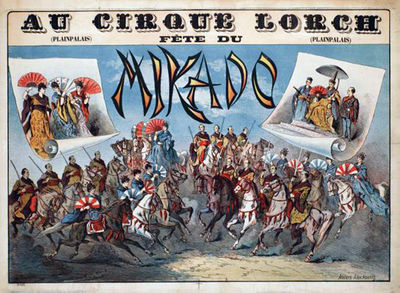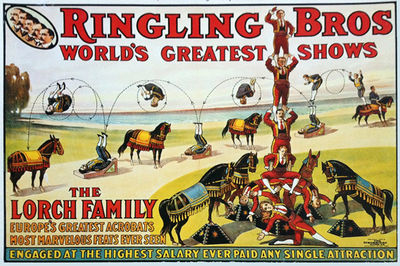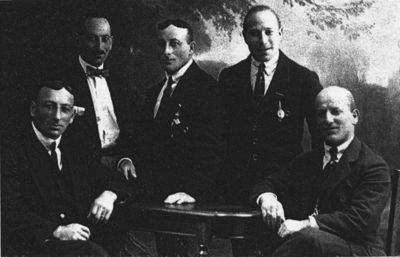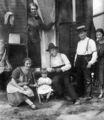The Lorch Family
From Circopedia
Acrobats, Circus Owners
By Dominique Jando
Circus Lorch
The Lorch family was a highly respected Jewish circus family that owned a circus in Germany intermittently from the nineteenth century until 1930. Founded by Hirsch Lorch (1817-1901) in the second half of the nineteenth century, Circus Lorch was continued by his sons, Adolf (1845-1918), who was born in Manheim on May 4, 1845, and Louis (1847-1924), born in Lörrach, in Baden-Württemberg, on July 14, 1847. Before the turn of the twentieth century, the brothers worked in partnership, and their Circus Gebrüder Lorch traveled principally in southern Germany, Switzerland, and Austria.
The family acts presented in the show included horsemanship and a remarkable Risley actAct performed by Icarists, in which one acrobat, lying on his back, juggles another acrobat with his feet. (Named after Richard Risley Carlisle, who developed this type of act.) performed by Louis’s children, which would acquire a towering reputation on the international circus and variety scene during the first half of the twentieth century. The circus maintained winter quarters in Eschollbrücken (today part of Pfungstadt, in the district of Darmstadt-Dieburg) in southern Hessen, where Hirsch Lorch and his family had settled in 1870.
The Lorch Family
At the beginning of the twentieth century, while Adolf continued to manage the circus, Louis and his many children went on their own with their Risley actAct performed by Icarists, in which one acrobat, lying on his back, juggles another acrobat with his feet. (Named after Richard Risley Carlisle, who developed this type of act.). (Under the sole management of Adolf, Circus Lorch lasted until the beginning of WWI.) With up to eleven performers (family members and partners or apprentices), and at times, horses, Louis’s Lorch Family act was one of the world’s biggest—and indeed one of the best—Risley acts. A true star attraction(Russian) A circus act that can occupy up to the entire second half of a circus performance. and very much sought after, it toured for nearly three decades with considerable success in Europe, the United States and South America.
In 1909, the Lorch Family troupe sailed to the New World, where their act was featured with the Ringling Bros. Circus; it remained there until 1912, working in American vaudeville during the winter months. Even after he stopped being an active participant in the act, Louis continued to travel with his family until his death in 1924—after which his eldest son, Julius (1875-1942), born December 11, 1875 in Neuwied-am-Rhein, succeeded him as head of the troupe. The most outstanding feats in the Lorch Family act were a series of three consecutive double somersaults that Julius’s son Egon (1900-1954) turned on his father’s feet, and an extremely rare triple somersault. From 1923 to 1925, the Lorch family participated in Circus Sarrasani’s first South American tour: It is during this tour that Louis died, in Buenos Aires, in 1924.Like all circus families, the Lorches were related by marriage to other circus dynasties. The most notable alliances were that of Rosa Lorch (1876-1959), one of Julius’s sisters and a talented equestrienneA female equestrian, or horse trainer, horse presenter, or acrobat on horseback., who married Alfons Althoff (1873-1916), with whom she moved to New York in 1914, and the equestrienneA female equestrian, or horse trainer, horse presenter, or acrobat on horseback. Irene Danner (1923-2006), Julius’s granddaughter, who married the clown Peter Bento (1923-2013).
Adolf Lorch married three times. His first wife was Adolfina Ackermann (1842-1873), who gave him two daughters, Rosa (b.1867) and Hilda (b. 1869). His second wife was Amalie Dienhelt (1834-1886), whom he married in 1875; they had an adopted daughter, Amalie Stein (1865-1937). Finally, in 1889, Adolf married the equestrienneA female equestrian, or horse trainer, horse presenter, or acrobat on horseback. Ottilie Blume (1869-1900), who gave him three more children, Olga (b.1889), Alphons (1890-1940), and Feodora (b.1893). Adolf's sister Rosa (b.1867) married the clown Emil Flumm, and his sister Hilda (b.1869) married the aerialistAny acrobat working above the ring on an aerial equipment such as trapeze, Roman Rings, Spanish web, etc. Charles Szemanovicz.
Louis married Johanna Meyer (1852-1939), the daughter of a butcher; together they had ten children: The aforementioned Julius (1875-1942) and Rosa (1876-1959), Jeanette (1879-1954), Arthur (1881-1942), Helene (b.1883), Eugen (1885-1943), Adolph (1887-1940), Felix (1888-1891), Hedwig (1890-1966), and Rudolf (1893-1944). Several of them participated in the Risley actAct performed by Icarists, in which one acrobat, lying on his back, juggles another acrobat with his feet. (Named after Richard Risley Carlisle, who developed this type of act.).
The Rise And Tragic Fall Of The New Circus Lorch
In 1927, the brothers Julius, Arthur and Rudolph Lorch acquired the circus of Wilhelm Althoff (1853-1934), which served as foundation for a new Circus Lorch. During the winter months, the brothers continued to take engagements in circus and variety shows in Europe with their Risley actAct performed by Icarists, in which one acrobat, lying on his back, juggles another acrobat with his feet. (Named after Richard Risley Carlisle, who developed this type of act.), which they featured in their own circus during its touring season in southern Germany. Circus Lorch was a medium-size circus, but it presented nonetheless high-quality programs—which had included such luminaries as the legendary equestrienneA female equestrian, or horse trainer, horse presenter, or acrobat on horseback. Therese Renz (1859-1938), not to mention their own Lorch Family Risley actAct performed by Icarists, in which one acrobat, lying on his back, juggles another acrobat with his feet. (Named after Richard Risley Carlisle, who developed this type of act.).Alas the rise of the National Socialist Party (the Nazi party) in Germany, combined with its rabid anti-Semitism and a dreadful economic situation—rendered even tougher for Jewish enterprises which were systematically boycotted—made it impossible for the Lorches to continue to run their circus: They were forced into bankruptcy in 1930. (They shared this dreadful fate with other famous Jewish circus families such as the Blumenfelds and the Strassburgers.) To make matters worse, by 1933, when the Nazi Party took power in Germany, the Lorches found themselves unwelcome in their hometown of Eschollbrücken.
Eventually several members of the Lorch family were captured and deported during WWII. Julius, Rudolf and Arthur were in Belgium with their sister Jeanette when the German forces invaded that country in 1940. Julius and Jeanette were able to hide, but Rudolf and Arthur were captured by the Gestapo and sent to forced labor in the French concentration camp of Gurs, and later to Auschwitz, where they were murdered. Julius lived in extreme poverty in Belgium, and virtually died of despair in 1942, at age sixty-seven. His wife, Sessie, was captured in 1943 and sent to Auschwitz, where she died after two months; Eugen was also murdered at Auschwitz.
Alice Lorch, Julius’s daughter who had married the German acrobat Hans Danner, was luckier: She and her daughters, Irene and Gerda, were hidden during that time by Adolph Althoff (1913-1998) in his circus, and survived WWII and the Nazi regime unharmed. Some others were fortunate to escape to England, Italy, and America.
Although a few of the family’s surviving members remained in the circus after the War, Circus Lorch disappeared forever in the catastrophe, and sadly, the great Lorch circus dynasty went with it, never regaining its former status in the circus world. Yet with their circus and, above all, their exceptional Risley actAct performed by Icarists, in which one acrobat, lying on his back, juggles another acrobat with his feet. (Named after Richard Risley Carlisle, who developed this type of act.), the Lorches wrote an important chapter of circus history. This fact was recognized by the Stadtmuseum of Pfungstadt, which installed an exhibit on the Lorch Family in 2014.
Suggested Reading
Ingebord Prior, Der Clown und die Zirkusreiterin (Munich, Piper Verlag GmbH, 1997) — ISBN 3-89029-196-1


















